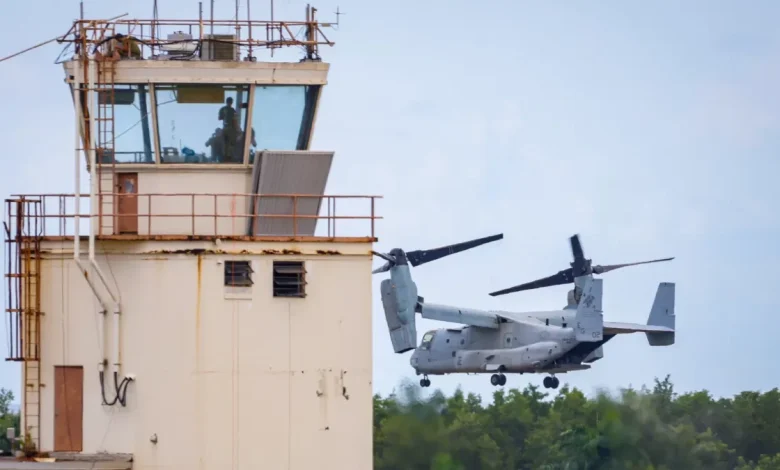The US military’s plan to revive old bases in Latin America

In the near future, U.S. troops could once again be based out of Ecuador after leaving 16 years ago. Ecuador is set to vote this weekend on a constitutional assembly that could allow foreign militaries to operate bases in the country, including the United States.
The Trump administration and Ecuador have been discussing security cooperation in recent months, including the possibility of once again basing American troops in the port city of Manta. Earlier this month, U.S. Secretary of Homeland Security Kristi Noem visited the site with Ecuadorian President Daniel Noboa, as well as another military installation, according to Noboa’s office. The Pentagon has not said if it plans to send forces back to the country if allowed, but the referendum could open the door for an American footprint in the country.
The potential return to Manta is part of a wider move by the U.S. military to reactivate and revive several bases around Latin America that it previously turned over or deactivated. The move comes as the military shifts away from the Middle East and into the western hemisphere. The Pentagon is actively working on rebuilding its infrastructure in the Caribbean and Central America at the same time it is deploying a large number of forces to the region under the auspices of tackling drug trafficking. The United States has carried out 20 announced strikes on small ships in the Caribbean and eastern Pacific accused of trafficking drugs, killing at least 79 people according to official White House and Pentagon statements. But the infrastructure being revived would be capable of more than just airstrikes on small boats.
Top Stories This Week
Alongside the potential return to Ecuador, U.S. troops and contractors have renovated bases inside American territory in the region — at Naval Station Roosevelt Roads in Puerto Rico — and outside of it, such as the former Fort Sherman in Panama. Roosevelt Roads, deactivated in 2004 after a nearby munitions range closed, came to life again this fall when the Pentagon sent F-35B fighter jets to Puerto Rico. Since then, satellite imagery and photographs have captured major renovations on the base’s airstrip, a surge in tents for construction and a general overhaul of the base’s infrastructure. Meanwhile, in Panama, conventional troops including U.S. soldiers and Marines, began training in a new jungle warfare school using the previously abandoned base, 25 years after it was handed over to the Panamanian state.
The U.S. base in Ecuador, part of the Eloy Alfaro International Airport in Manta, was home to American forces starting in 1999. The U.S. military left Manta in 2009 after a decade of operations, when Ecuador banned foreign militaries inside the country. The potential return to Manta is notable because it would give the U.S. a presence on the Pacific side of Latin America, after it began strikes on ships in the eastern part of the ocean in recent weeks. A Pentagon official told Task & Purpose that the Department of Defense was aware of the request by Ecuador for American assistance and that the U.S. provides training and education to the country.
US Marines offload supplies from a V-22 aircraft at Naval Station Roosevelt Roads in Ceiba, Puerto Rico. Photo by Miguel J. Rodriguez Carrillo/AFP via Getty Images
Rebuilding old bases would likely give the United States military greater operational capabilities in the region. Thousands of sailors and Marines were moved into the Caribbean over late summer and early fall, but most are on ships deployed to the region. Extant U.S. Southern Command bases are operational in Puerto Rico and Honduras, where the forward-deployed Joint Task Force-Bravo is based. As part of the buildup, the U.S. is relying on nearby neighbors. Several U.S. Air Force and special operations planes have been spotted at air bases in El Salvador.
Reviving old bases and airfields isn’t a new strategy, either. As part of a pivot to the Pacific after two decades in the Middle East, the military reactivated and updated several island outposts. Those range from World War II airfields, including one on Peleliu, to potential ones in the cold Aleutian Islands.
A Marine makes a water filtration device during jungle warfare training in Panama. Army photo by Trey Woodard
The referendum and Noem’s visit to Ecuador come as the Pentagon formalized its forces in the Caribbean under a new task force last month (renamed Joint Task Force-Southern Spear this week) and announced a counter-narcotics plan dubbed Operation Southern Spear. The base in Manta, for instance, was used primarily for actions against drug traffickers.
This week, Venezuela’s government announced it was mobilizing its military in a show of force against the growing U.S. military presence — and in that same period of time, the USS Gerald R. Ford aircraft carrier and its strike group entered into SOUTHCOM’s area of responsibility, increasing U.S. naval power in the region.
Task & Purpose Video
Each week on Tuesdays and Fridays our team will bring you analysis of military tech, tactics, and doctrine.
Nicholas Slayton is a Contributing Editor for Task & Purpose. In addition to covering breaking news, he writes about history, shipwrecks, and the military’s hunt for unidentified anomalous phenomenon (formerly known as UFOs).




